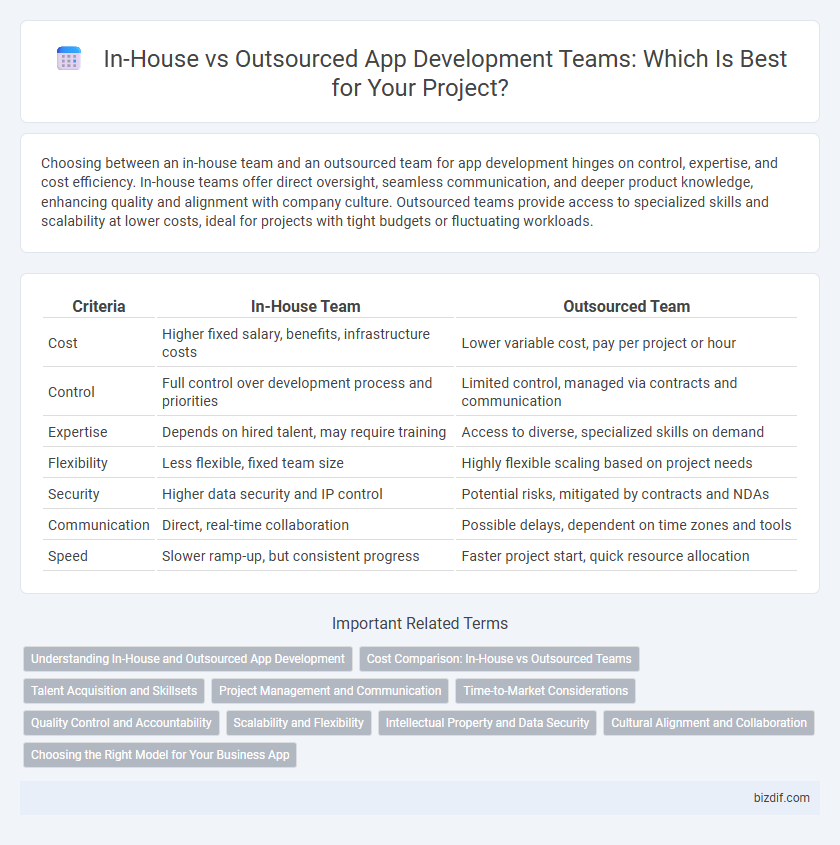Choosing between an in-house team and an outsourced team for app development hinges on control, expertise, and cost efficiency. In-house teams offer direct oversight, seamless communication, and deeper product knowledge, enhancing quality and alignment with company culture. Outsourced teams provide access to specialized skills and scalability at lower costs, ideal for projects with tight budgets or fluctuating workloads.
Table of Comparison
| Criteria | In-House Team | Outsourced Team |
|---|---|---|
| Cost | Higher fixed salary, benefits, infrastructure costs | Lower variable cost, pay per project or hour |
| Control | Full control over development process and priorities | Limited control, managed via contracts and communication |
| Expertise | Depends on hired talent, may require training | Access to diverse, specialized skills on demand |
| Flexibility | Less flexible, fixed team size | Highly flexible scaling based on project needs |
| Security | Higher data security and IP control | Potential risks, mitigated by contracts and NDAs |
| Communication | Direct, real-time collaboration | Possible delays, dependent on time zones and tools |
| Speed | Slower ramp-up, but consistent progress | Faster project start, quick resource allocation |
Understanding In-House and Outsourced App Development
In-house app development involves a dedicated team working internally within a company, offering greater control, faster communication, and deeper alignment with organizational goals. Outsourced app development leverages external specialists or firms, providing access to diverse expertise, cost-efficiency, and scalability for specific project needs. Choosing between in-house and outsourced teams depends on factors like budget, project complexity, and desired level of involvement in the development process.
Cost Comparison: In-House vs Outsourced Teams
In-house app development teams typically incur higher costs due to salaries, benefits, office space, and equipment expenses, averaging $100,000 to $150,000 annually per developer in the U.S. Outsourced teams offer cost efficiency, with rates ranging from $25 to $75 per hour depending on the region, significantly lowering overall project expenses. Companies must weigh these financial aspects against project scope and control requirements to determine the optimal investment strategy.
Talent Acquisition and Skillsets
In-house app development teams offer direct control over talent acquisition, enabling tailored hiring to match specific project requirements and facilitating seamless collaboration with existing staff. Outsourced teams provide access to diverse skillsets and specialized expertise that may be difficult to source locally, often accelerating development timelines while reducing overhead costs. Balancing in-house depth with outsourced flexibility allows businesses to optimize technical capabilities and adapt to evolving app development needs efficiently.
Project Management and Communication
Managing an in-house app development team offers direct control over workflows, fostering real-time communication and immediate issue resolution, which enhances project alignment and quality assurance. Outsourced teams often rely on predefined communication protocols and project management tools to coordinate efforts across different time zones, requiring clear documentation and regular updates to maintain transparency and meet deadlines. Effective project management in both setups depends on rigorous task tracking, clear role definitions, and consistent feedback loops to ensure timely delivery and agile response to changing requirements.
Time-to-Market Considerations
In-house app development teams offer greater control over project timelines, enabling faster iterations and alignment with company goals, which can reduce the overall time-to-market. Outsourced teams may face delays due to communication barriers, differing time zones, and onboarding processes, potentially extending development cycles. Selecting the appropriate team impacts the speed of app delivery and responsiveness to market changes critical for competitive advantage.
Quality Control and Accountability
In-house app development teams provide direct oversight, ensuring rigorous quality control through immediate feedback and close collaboration, which enhances accountability. Outsourced teams may face challenges in maintaining consistent quality due to communication barriers and less control over daily processes, potentially impacting deliverables. Leveraging project management tools and clear contract terms can improve accountability and quality standards in outsourced development projects.
Scalability and Flexibility
In-house app development teams offer limited scalability and flexibility due to fixed resources and longer hiring cycles, which can slow project adaptation to market changes. Outsourced teams provide greater scalability by quickly adjusting team size and skill sets based on project demands, enabling faster iteration and responsiveness. Leveraging outsourced resources enhances flexibility, allowing businesses to access specialized expertise without long-term commitments or overhead costs.
Intellectual Property and Data Security
In-house app development teams maintain greater control over intellectual property and data security by keeping all processes and resources within the organization, reducing risks of information leaks. Outsourced teams often require rigorous contractual agreements and secure communication channels to protect sensitive data and proprietary technology. Companies must evaluate internal expertise and vendor reliability to safeguard their intellectual property effectively throughout the development lifecycle.
Cultural Alignment and Collaboration
Cultural alignment significantly impacts the efficiency of in-house and outsourced app development teams, as shared values and communication styles foster smoother collaboration. In-house teams benefit from daily face-to-face interactions that strengthen team cohesion and quick decision-making. Outsourced teams require intentional strategies to bridge cultural gaps through clear communication protocols and regular virtual meetings to maintain project alignment and productivity.
Choosing the Right Model for Your Business App
Selecting the right development model between an in-house team and an outsourced team depends on factors such as budget, project complexity, and control requirements. In-house teams offer direct communication, deep company knowledge, and agile iterations, while outsourced teams provide cost-efficiency, access to specialized skills, and scalability. Evaluating your business goals, timeline, and long-term maintenance needs ensures the optimal balance between quality, flexibility, and resource allocation for your app development project.
In-House Team vs Outsourced Team Infographic

 bizdif.com
bizdif.com